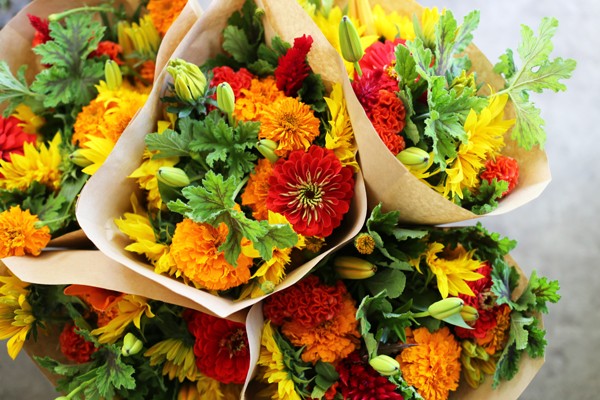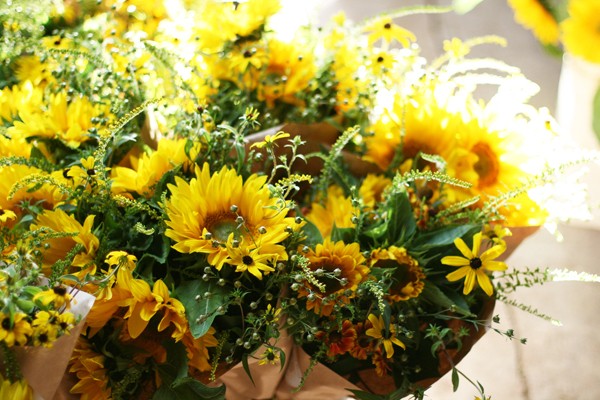In the years since I authored my first Growing for Market article, the flower industry has changed dramatically. Or, as the T: The New York Times Style Magazine described it, “This country is in the midst of a floral revolution.”
Florists and consumers are seeking out local, seasonal flowers, and weekend shoppers at farmers markets find stalls stocked with flowers as well as produce. Meanwhile, many hometown brick and mortar flower shops are being forced to evolve and innovate as they face increasing competition from online companies and grocery floral departments, which have become one of the fastest growing sectors in the industry. While most chain stores still rely heavily on imported blooms, many are now actively seeking to source locally-grown flowers, providing new sales outlets for growers.
One of the most widely requested items from floral departments is mixed bouquets. The key to making mixed or market bouquets profitable is planning and extreme efficiency.
Market bouquets were one of the key stepping stones that we used to grow Floret. When most stores could only take a limited number of straight bunches of flowers each week, their appetite for fresh, local bouquets was insatiable. For many years, our little two-acre plot churned out thousands of bouquets every summer for grocery stores, bouquet subscriptions and flower shops.
In the earliest days of Floret, pulling together a few bouquets felt effortless. A quick stroll around the yard, and I could gather more than enough ingredients to put together something beautiful. But as time went on and my hobby turned into a business, having a steady supply of enough of the right kind of ingredients became very challenging.
It’s one thing to be able to whip up a few bouquets with goodies from the garden, and a whole other matter to be able to fill a twice-weekly market bouquet order for a grocery chain or flower CSA. Some weeks the stars would align and I’d have everything I needed, and some weeks I’d be missing many of the staples like foliage and filler that were required to make beautiful bouquets, fast.

After seeing the amazing response that our market bouquets received, I knew we were onto something. But having to endure a season filled with stress because I was constantly scraping for enough of the right things to make up a batch of bouquets, I decided to invest some serious time into mastering bouquet production on a large scale.
Farm planning is always a lot of work. Thinking out an entire season, making best guess estimates, predicting demand, scheduling seed sowing and transplanting for dozens of weeks can leave your head spinning. And once you add bouquets into the mix, the puzzle gets even more complex.
I invest a lot of energy each winter into planning, and focus a good portion of that time on our bouquet program. There is nothing worse than having to put together 400 bouquets when you’re out of focal flowers or critical filler. Trust me; I’ve been there and this stress can be avoided with proper planning ahead.
To simplify the process, I break the bouquet season into three separate time blocks:
Spring (mid May-June)
Summer (July-August)
Fall (September-early October)
While we have flowers starting in mid-March and continuing until early November, market bouquets are only offered during the most abundant months of the year, which here in Washington State are May through October.
Next, within each seasonal block I sort potential ingredients into five main categories. This ensures that I have the balanced mix necessary for fast and easy bouquet making, without any production gaps. I aim for about 50% of the mix being filler, 30% being disks and the remaining 20% split between spikes, the focal bloom and airy elements.
Focal: This is the main flower that the bouquet will be built around, typically something large and showy like a sunflower or lily.
Spikes: A colorful vertical element that really grabs the customer’s attention and accents the focal bloom. Celosia, snapdragons, stock and larkspur are all favorite spike ingredients.
Disk: These round-headed flowers are great at taking up space and filling in holes throughout the bouquet. Marigolds, zinnias and asters are all great, easy to grow disks.
Filler: I rely heavily on greens to fill out each bouquet and provide textural interest. This category is the most important! Bells of Ireland, raspberry greens, Queen Anne’s lace, mint and amaranth are all wonderful workhorses.
Airy Elements: These delicate ingredients add whimsy, movement and interest to any bouquet. They also have a great way of catching customers’ attention as they breeze by the floral display. Grasses, pods and grains are all fun ingredients.

Once I have all of the seasonal ingredients sorted into their respective categories, I can see where the production gaps are. For instance, in spring, focal and disk flowers are blooming in abundance, but filler is often scarce. So I put extra focus on stocking the field with lots of early greens like mint, raspberry foliage and bells of Ireland that will fill that category up.
A sample market bouquet in June might include: one peony (focal), three stems of snapdragons (spike), three stems of sweet William (disk), five stems of apple mint (filler), three stems of lady’s mantle (filler) and a few agrostemma (air).
Each climate and market is different, so you’ll need to play around with what grows well for you, but hopefully this little formula will help you in your planning process and highlight seasons and categories that need extra focus.
Market bouquet ingredients
Spring bouquet favorites
Focals: peonies, tulips, ranunculus, allium
Spikes: stock, Canterbury bells, foxglove, delphinium, lupine, snapdragons, larkspur
Disks: anemones, calendula, sweet William, godetia, Iceland poppies, hellebores, small flowered allium
Filler: mint, bells of Ireland, bupleurum, Queen Anne’s lace, honeywort, lady’s mantle, orlaya, orach, raspberry greens, miscellaneous woodies, sweet rocket
Air: love-in-a-mist, bachelor’s buttons, Chinese forget-me-nots, corn cockle, grains, soapwort, columbine, lunaria
Summer bouquet favorites
Focals: sunflowers, lilies, zinnias, lisianthus
Spikes: snapdragons, celosia, gladiolas, salvia, bee balm, clarkia, stock
Disks: cosmos, zinnias, black-eyed Susan, marigolds, yarrow, echinacea, phlox, celosia, strawflower, tansy, ageratum, sweet William
Filler: didiscus, lavatera, amaranth, bells of Ireland, honeywort, basil, scented geranium foliage, ninebark, raspberry greens, chocolate lace flower, Queen Anne’s lace, oregano, artemisia, statice, goldenrod, feverfew, cress, hypericum
Air: ornamental grasses, pincushion flower, poppy pods, globe amaranth, rudbeckia triloba, love-in-a-mist pods, flax, orach
Autumn bouquet favorites
Focals: sunflowers, zinnias, chrysanthemums, ornamental kale, lisianthus
Spikes: celosia, ornamental peppers, millet, salvia leucantha, broom corn
Disk: asters, cosmos, zinnias, black eyed Susan, marigolds, celosia, strawflowers, sedums
Filler: statice, scented geranium, perilla, amaranth, basil, pineapple sage, ninebark, goldenrod, peegee hydrangeas, sweet Annie, eucalyptus, perennial asters, cress, hypericum
Air: orach, love-in-a-mist pods, ornamental grasses, grains, flax, hyacinth bean, wild rosehips
For more information on the bouquet ingredients, go to
https://tinyurl.com/y7rl5ay4.
Whether you plan to make market bouquets for grocery stores, a bouquet CSA or farmers market, efficiency is critical. At the height of our production, we cranked out an average of 400-600 market bouquets every week from mid-May through mid-September for our grocery store accounts. If I had spent 5 or 10 minutes making each bouquet, there’s no way I’d have been able to fill all of the orders, complete all of the necessary farm tasks and get any sleep at night. They say “time is money” and the less time you spend making bouquets, the more money you’ll make in the end. Our goal is to make and wrap a bouquet in one minute or less. It takes me 45 seconds to assemble bouquets and then another 10-15 second to chop, rubber band and sleeve.

Here are my top tips for making beautiful market bouquets fast:
- Pre-sticker and count all of your bouquet sleeves so that you don’t have to stop once you get rolling.
- It’s also important to prewash and fill the buckets you’ll be using to transport the finished bouquets ahead of time.
- Have the exact number of buckets you need to fill the order ready so you don’t need to continually recount.
- When harvesting, remove all of the foliage on the lower half of the stems, and clean off any imperfections before you bring the flowers and foliage inside. If you have to clean as you go, it’ll add a lot of unnecessary time and frustration once you start assembling bouquets.
- Make sure you have all categories represented (focal, spike, disk, filler, air) and always harvest some extra filler, just in case you need it.
- It’s important that all of the flowers and foliage are fully hydrated and conditioned before you begin so they don’t wilt while you’re working.
Once it’s time to assemble the bouquets, take a big scoop of each of the ingredients you’ll be using and place them into separate piles on a work table, keeping all flower heads facing the same direction. It should look like an assembly line. I have a tall L-shaped counter in our garage that is perfect but you can also use a folding table with risers made out of PVC pipe slipped under the legs. Standing height tables are very important so you’re not leaning over for hours, which could hurt your back.
Working from one end of the table to the other, quickly grab stems from each pile and add to the bouquet, twisting with each addition. Do not stop and fuss with each stem, just lay it on the bouquet and keep going!
Once a bouquet is the desired size, cut the stems with a metal table-mounted chopper, rubber band it and slip it into a pre-stickered sleeve. We put five bouquets per bucket, so rather than sticking them into water as we go, I make a pile of five and then bucket them all at once. This saves a huge amount of time and struggle since bouquets like to try and jump out of the bucket if you add them as you go.
Bouquet making supplies
Table-mounted stem chopper: This flower “guillotine” will save your wrists and increase efficiency tenfold. You can find them at your local flower wholesaler or online from Floral Supply Syndicate. www.fss.com
Kraft paper sleeves from A-Roo: These paper sleeves give bouquets a beautiful, organic, finished look and don’t require any assembly. My favorite size for our standard market bouquet is 18x16x5. If you want samples of all the sizes they offer, just give A-Roo a call and they pop them in the mail for free. www.a-roo.com
Stickers: We have been working with Grower’s Discount Labels for a decade now and both their products and service are unmatched. If you’re selling to grocery chains, it’s great to have professional looking stickers with your farm name, website and a barcode on them. I recommend getting circle-shaped stickers. My kids were always in charge of stickering all our sleeves and the round shape ensured that they never looked crooked. Our bouquet stickers are 2 ¾” round white gloss labels. If you’re doing a lot of stickering, a label dispenser is awesome. We have five of the 3” wide models which Grower’s Discount Labels sells. www.growersdiscountlabels.com
Rubber bands: Having plenty of these on hand is essential. My favorite size is #19 and they can be purchased in bulk from Uline. Make sure that you don’t leave them in direct sunlight or they will become brittle and snap on you. www.uline.com
Barcodes: Having barcodes is a huge plus when selling to grocery chains. We have six separate codes that we assign to different price points. All of our stickers have barcodes on them and depending on what the product is, we apply the appropriate sticker. If you work with Grower’s Discount Labels, they can walk you through the process of getting them and adding them to your labels. We purchased our barcodes from Bar Codes Talk for around $5 each. www.barcodestalk.com
Adding mixed bouquets to your farm’s offerings is a great way to move a lot of flowers each week, especially when you have a big flush of blooms. With a little extra winter planning and a commitment to implementing some efficiency hacks, you’ll be able to crank out a huge amount of bouquets each week during the peak of the flower season.
Erin Benzakein is the founder of Floret, a flower farm in Washington’s Skagit Valley. Benzakein was the Growing for Market cut flower columnist for many years and is the author of Floret Farm’s Cut Flower Garden: Grow, Harvest & Arrange Stunning Seasonal Blooms, which won the 2018 American Horticulture Society Award. Her Instagram account @floretflower is followed by more than 500,000 users worldwide.




 For most established growers, the easiest place to start selling flowers will be mixed bouquets and single stem/small bunch retail sales. These are the flowers you can sell to your existing customers and they are easy to incorporate into farmers market, CSA, and grocery sales. But there are lots of other outlets out there, including florists, weddings and events, business subscriptions, value added products, and wholesalers.
For most established growers, the easiest place to start selling flowers will be mixed bouquets and single stem/small bunch retail sales. These are the flowers you can sell to your existing customers and they are easy to incorporate into farmers market, CSA, and grocery sales. But there are lots of other outlets out there, including florists, weddings and events, business subscriptions, value added products, and wholesalers.

 Since its founding in 1968 by my husband Eliot Coleman, Four Season Farm has sought to produce the best vegetables possible, using soil-based organic methods, on a small amount of land. When I showed up in 1991, Eliot had begun to pioneer winter vegetable production, and I was delighted to give up the landscape design business I’d run in Connecticut and grow veggies with him. Then, about 10 years ago, flowers started to creep in.
Since its founding in 1968 by my husband Eliot Coleman, Four Season Farm has sought to produce the best vegetables possible, using soil-based organic methods, on a small amount of land. When I showed up in 1991, Eliot had begun to pioneer winter vegetable production, and I was delighted to give up the landscape design business I’d run in Connecticut and grow veggies with him. Then, about 10 years ago, flowers started to creep in.



 Marketing is the other half of the battle
Marketing is the other half of the battle





